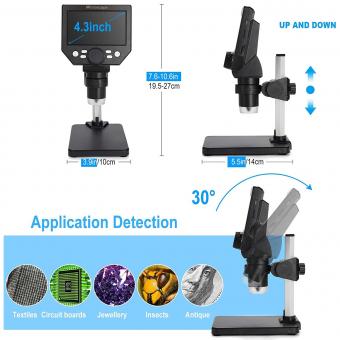Why Can An Electron Microscope Detect More Detail ?
An electron microscope can detect more detail than a light microscope because it uses a beam of electrons instead of light to magnify the specimen. Electrons have a much shorter wavelength than visible light, which allows for higher resolution and greater magnification. Additionally, electron microscopes use electromagnetic lenses to focus the electron beam, which can achieve much higher magnification than the glass lenses used in light microscopes. Finally, electron microscopes can also use different types of detectors to capture the electrons that pass through or scatter off the specimen, which can provide additional information about the sample's structure and composition.
1、 Higher Magnification
An electron microscope can detect more detail than a light microscope because of its higher magnification. The electron microscope uses a beam of electrons instead of light to magnify the specimen, which allows for much higher magnification and resolution. The wavelength of electrons is much smaller than that of light, which means that electron microscopes can achieve much higher magnification than light microscopes.
In addition to higher magnification, electron microscopes also have better resolution than light microscopes. Resolution refers to the ability to distinguish between two closely spaced objects. The resolution of a microscope is limited by the wavelength of the radiation used to image the specimen. Since the wavelength of electrons is much smaller than that of light, electron microscopes can achieve much higher resolution than light microscopes.
Recent advances in electron microscopy have further improved its ability to detect more detail. For example, cryo-electron microscopy (cryo-EM) allows for the imaging of biological specimens in their native state, without the need for staining or fixation. This technique has revolutionized the field of structural biology, allowing researchers to visualize the structures of proteins and other biomolecules at near-atomic resolution.
In summary, an electron microscope can detect more detail than a light microscope because of its higher magnification and better resolution. Recent advances in electron microscopy have further improved its ability to detect more detail, making it an essential tool for researchers in a wide range of fields.

2、 Smaller Wavelength of Electrons
An electron microscope can detect more detail than a traditional light microscope because of the smaller wavelength of electrons. Electrons have a much smaller wavelength than visible light, which allows them to resolve much smaller structures. The wavelength of electrons is on the order of picometers, while the wavelength of visible light is on the order of hundreds of nanometers. This means that electron microscopes can resolve structures that are much smaller than what can be seen with a light microscope.
In addition to the smaller wavelength of electrons, the latest point of view suggests that electron microscopes can also detect more detail because they use electrons instead of photons. Electrons interact differently with matter than photons do, which allows them to provide different types of information about the sample being studied. For example, electrons can be used to create high-resolution images of the surface of a sample, while photons are better suited for studying the chemical composition of a sample.
Furthermore, electron microscopes can also be used to study samples in different ways, such as in transmission mode or scanning mode. In transmission mode, electrons pass through a thin sample and are detected on the other side, allowing for high-resolution imaging of the internal structure of the sample. In scanning mode, a focused beam of electrons is scanned across the surface of a sample, allowing for detailed imaging of the surface topography.
Overall, the smaller wavelength of electrons and the unique interactions between electrons and matter make electron microscopes a powerful tool for studying the structure and properties of materials at the nanoscale.

3、 Better Resolution
An electron microscope can detect more detail than a light microscope due to its better resolution. The resolution of a microscope refers to its ability to distinguish two closely spaced objects as separate entities. The resolution of a light microscope is limited by the wavelength of visible light, which is around 400-700 nanometers. In contrast, the resolution of an electron microscope is limited by the wavelength of electrons, which is much smaller than that of visible light.
Electron microscopes use a beam of electrons instead of visible light to illuminate the sample. The electrons have a much smaller wavelength than visible light, which allows them to interact with the sample at a much higher resolution. This means that electron microscopes can detect much smaller details in a sample than light microscopes.
In addition to better resolution, electron microscopes also have other advantages over light microscopes. For example, they can be used to image samples in a vacuum, which allows for the imaging of samples that would be damaged by exposure to air. They can also be used to image samples at very high magnifications, which is useful for studying the structure of materials at the atomic level.
Recent advances in electron microscopy have further improved its resolution and capabilities. For example, the development of aberration-corrected electron microscopy has allowed for even higher resolution imaging of samples. Additionally, the use of cryogenic electron microscopy has enabled the imaging of biological samples at near-atomic resolution.
Overall, the better resolution of electron microscopes is due to their use of electrons instead of visible light to illuminate the sample. This allows for the detection of much smaller details in a sample, and recent advances in electron microscopy have further improved its capabilities.

4、 Improved Contrast
An electron microscope can detect more detail than a light microscope due to improved contrast. In a light microscope, the contrast is limited by the wavelength of visible light, which is around 400-700 nanometers. This means that structures smaller than this cannot be resolved, and those that can be seen may not have enough contrast to distinguish them from their surroundings.
In contrast, an electron microscope uses a beam of electrons with a much shorter wavelength, typically around 0.005 nanometers. This allows for much higher resolution and the ability to see structures that are much smaller than those visible with a light microscope. Additionally, the electrons used in an electron microscope interact more strongly with the sample, providing greater contrast and allowing for the visualization of structures that may be difficult to see with a light microscope.
Recent advancements in electron microscopy technology have further improved contrast and resolution. For example, the development of aberration-corrected electron microscopy has allowed for the correction of distortions in the electron beam, resulting in even higher resolution and improved contrast. Additionally, the use of cryogenic electron microscopy has allowed for the imaging of biological samples in their native state, providing unprecedented insights into the structure and function of biological molecules.
In summary, an electron microscope can detect more detail than a light microscope due to improved contrast, which is achieved through the use of a shorter wavelength and stronger interactions between the electrons and the sample. Ongoing advancements in electron microscopy technology continue to push the limits of what can be seen and understood at the nanoscale.






























There are no comments for this blog.